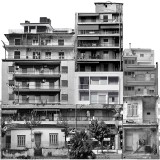This research paper studies the interventions made by the users on their dwellings over time, following the completion of the design process and construction, often at the heart of architectural thought. The way in which the occupant conceives his space and how he interprets / uses / appropriates / configures it. The architectural debate often focuses on the design and production as the highlights in the life of a building, considering it completed and at its peak when it gets photographed by architectural press, before its “consumption” by the users.
We think of consumption as a negative act in which something decays, as opposed to “production” which involves creation. In this perspective it seems reasonable that the architectural discourse focuses on design, while what happens to the building after its completion is of little importance.
This study aims to approach the phenomenon of user intervention in his space, organized in four sections. Firstly, a theoretical approach of the terms “user” and “flexibility” is attempted, through a historical view on the spread of modernism. Next, three examples of international settlements that have been modified by their occupants over time are analyzed: “Le Quartiers Modernes Frugès” by Le Corbusier, “Nid D’abeille & Semiramis” by Candilis & Woods and “Previ”, a mixture of international and Peruvian architects. We, then, study the refugee settlement of N. Ionia in Volos, a Greek example that shares common elements with the previously mentioned case studies, while we identify and classify the modifications it has endured. Lastly, a zoom-out in the city is attempted, in an effort to trace the initiatives of the refugee settlements on the building type that characterizes the greek urban landscape: the polykatoikia. A reference is made to its morphology and common variations carried out by the occupants are identified.
